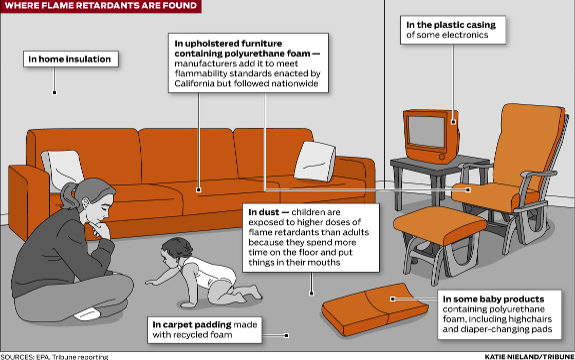Flame Retardants: 5 Dangerous Facts About these Toxins

 Flame retardants are found in everything from your carpeting to your couch, and though their name would suggest they have your safety in mind, these toxins have been linked to numerous negative health effects. Ironically, when they catch fire, they release more toxins which are more likely to kill someone than the flames themselves.
Flame retardants are found in everything from your carpeting to your couch, and though their name would suggest they have your safety in mind, these toxins have been linked to numerous negative health effects. Ironically, when they catch fire, they release more toxins which are more likely to kill someone than the flames themselves.
An investigative report from the Chicago Tribune entitled “Playing With Fire” took a long and hard look at the overabundance of flame retardants in modern society. Their report led to a documentary on HBO, Toxic Hot Seat, which highlighted the dangers of these toxins. They outlined the hidden dangers and little-known-facts about them; here are our top five:
- 1. Though they are no longer used in children’s pajamas, they are still used in children’s furniture and car seats. Actually, they are said to be present in nearly 80% of baby products. Before they are even born, babies are exposed to them—leading to the highest levels of flame retardant toxins present in newborn infants than ever before.
- 2. Studies have linked these chemicals to things like: infertility, birth defects, lowered IQs, behavioral problems, and cancers of the breasts, testicles, liver, and kidneys. Because it’s estimated 90 percent of Americans have the chemicals in their body, these are risks to take seriously.
- 3. Big Tobacco helped develop these toxins in the 1970s when 40 percent of the population smoked. In essence, they profited from what was causing the fires while simultaneously profiting off of what was sold as “fire prevention”.
- 4. They offer no benefits. A highly cited study that said flame-retardant furniture allowed 15 extra seconds of escape time in the event of a blaze didn’t use the flame retardants used in our home furnishings. Instead, it used NASA-style retardants. Still, this study is frequently used to support the inclusion of these chemicals in everything.
- 5. The chemical industry is spending millions to ensure flame retardants are now phased out.
While furniture makers will be allowed to begin producing mattresses and other products without flame retardants starting now, in 2014, they will likely make consumers pay a pretty penny for them. The chemical industry has fought this move tooth and nail and it’s likely they aren’t giving up yet.
Though it’s unlikely you can avoid all exposure to flame retardants, you can reduce the amount in your home by always looking out for carpeting, furniture, and other products containing PBDEs or polybrominated diphenyl ethers. These toxins are among the major toxic cover-ups in the US.
